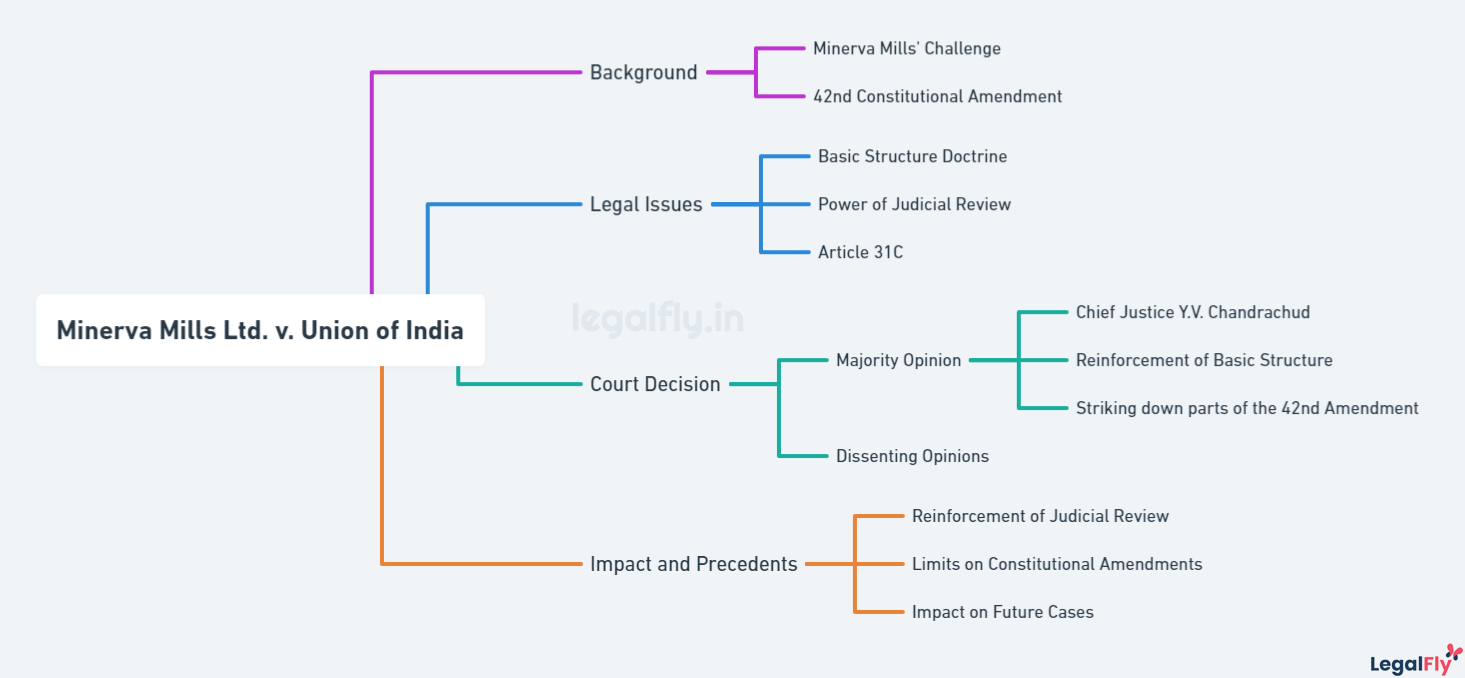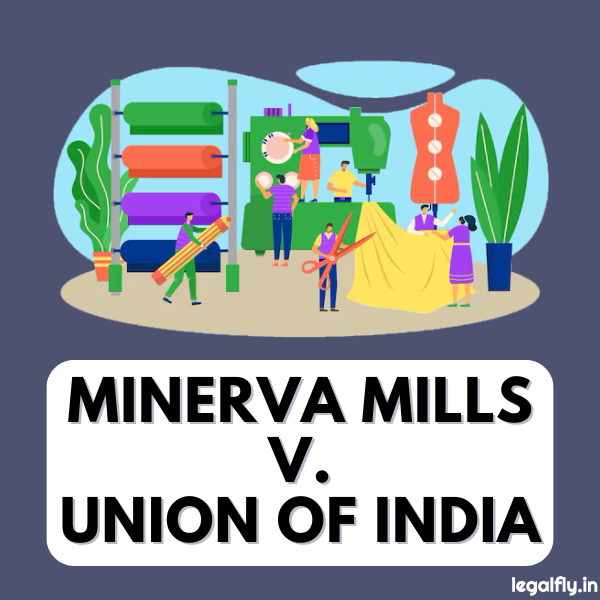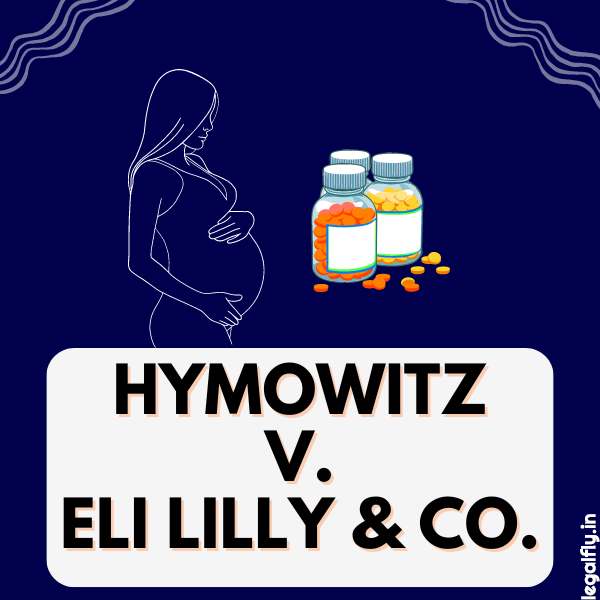Table of Contents
Case Name: Minerva Mills Ltd. v. Union of India
Court: Supreme Court of India
Year: 1980
Citation: AIR 1980 SC 1789
Introduction
The decision in Minerva Mills Ltd. v. Union of India is a landmark ruling in the annals of Indian constitutional law. The crux of this case centred around the constitutionality of the 42nd Amendment, specifically its impact on Articles 31C, 368(4), and 368(5). The Supreme Court, in this case, ruled that the Parliament cannot amend the Constitution in a way that destroys its basic structure. This set a critical precedent, delineating the boundaries of legislative power in amending constitutional provisions.

Minerva Mills Ltd. challenged the amendments on the grounds that they altered the balance of power between Fundamental Rights and Directive Principles of State Policy. The Supreme Court upheld the basic structure doctrine, originally established in the Kesavananda Bharati case, reaffirming that certain fundamental elements of the Constitution cannot be compromised. This ruling underscored the inviolability of India’s democratic framework and its essential features.
This case significantly influenced Indian democracy by ensuring that any attempt to undermine the core principles of the Constitution could be checked by judicial review. It affirmed that while the Parliament has the authority to amend the Constitution, such power is not absolute and is subject to limitations that preserve the basic structure.
Key Takeaways
- The Supreme Court ruled that Parliament cannot amend the Constitution in a way that destroys its basic structure.
- The decision reaffirmed the principles laid out in the Kesavananda Bharati case.
- The ruling ensures checks on legislative power to protect the fundamental elements of the Constitution.
Historical Background of the Case
The landmark case of Minerva Mills Ltd. v. Union of India revolved around the 42nd Amendment to the Indian Constitution and its implications for the balance between Fundamental Rights and Directive Principles of State Policy. This case was deeply rooted in the circumstances surrounding Minerva Mills Ltd.’s nationalization and the precedent set by Kesavananda Bharati v. State of Kerala.
The Context of the 42nd Amendment
The 42nd Amendment, also known as the “mini-Constitution,” was enacted in 1976 during the Emergency period. This Amendment aimed to reduce the Judiciary’s power and enhance the Parliament’s authority over the Constitution. It introduced significant changes, particularly to Articles 368 and 31C.
Articles 368 (4) and (5) curtailed the powers of judicial review, stating that constitutional amendments could not be challenged in any court. Article 31C allowed laws related to certain Directive Principles to override Fundamental Rights. These changes sparked significant debates about the erosion of crucial rights and the checks and balances system in India.
Minerva Mills and National Textile Corporation
Minerva Mills Ltd., a textile company, was nationalized under the Sick Textile Undertakings (Nationalisation) Act of 1974. The National Textile Corporation (NTC) was tasked with overseeing the management of these sick textile mills. This nationalization triggered legal challenges regarding the infringement of property rights and the overarching powers granted by the 42nd Amendment.
The owners of Minerva Mills argued that the amendments, particularly those under Article 31C, were unconstitutional as they took away their guaranteed Fundamental Rights. The case was a direct confrontation between individual rights and state-imposed policies aimed at societal welfare through the Directive Principles of State Policy.
Kesavananda Bharati Precedent
The Kesavananda Bharati v. State of Kerala decision in 1973 was pivotal in the Minerva Mills case. In Kesavananda Bharati, the Supreme Court held that while Parliament had wide powers to amend the Constitution, it could not alter its “basic structure.” This principle of the basic structure doctrine became the foundation for challenging the 42nd Amendment.

In Minerva Mills, the Supreme Court reaffirmed this doctrine, asserting that the amendments made under the 42nd Amendment violated the basic structure of the Constitution. The Court emphasized that any law or Amendment impinging upon the basic structure, including judicial review and Fundamental Rights, would be struck down.
These historical contexts highlight the interplay between legislative power and judicial oversight in maintaining the balance of India’s democratic framework.
Constitutional Provisions and Challenges
The Minerva Mills Ltd. v. Union of India case focused on key constitutional amendments and their clash with fundamental rights and the directive principles of state policy. The Supreme Court’s decision highlighted limitations on Parliament’s power to amend the Constitution.
Article 31C and Its Implications
Article 31C was a significant provision in the Indian Constitution. It aimed to place certain state policies above judicial review, safeguarding laws that pursued principles outlined in Part IV, the Directive Principles of State Policy. This meant laws that aimed to achieve social and economic justice could not be challenged for violating fundamental rights listed in Part III.
However, the 42nd Amendment went further by altering Article 31C. This Amendment stated that any law to give effect to any directive principle would not be deemed void even if it contravened fundamental rights. This raised concerns about unchecked legislative power and the erosion of fundamental rights, prompting judicial scrutiny.
The Petition and Challenge to Amendments
Minerva Mills Ltd. challenged Sections 4 and 55 of the 42nd Amendment, which amended Article 31C and introduced Articles 368(4) and 368(5). These changes aimed to limit judicial review and expand Parliament’s amending powers. Minerva Mills, a textile company in Karnataka, argued that these changes undermined the basic structure of the Constitution by placing directive principles above fundamental rights.
Justice P.N. Bhagwati and other judges heard the case and delivered a landmark judgement in 1980. The Court decided that while directive principles are important, they cannot override fundamental rights. Parliament’s amendment power under Article 368 is not absolute. The Supreme Court reaffirmed that the Constitution’s basic structure, which includes fundamental rights and judicial review, cannot be altered by any amendment.
The Supreme Court’s Verdict
In Minerva Mills Ltd. v. Union of India, the Supreme Court of India clarified key aspects of the Constitution’s amending power. The ruling emphasized the Basic Structure Doctrine and its impact on the validity of certain constitutional amendments.
Basic Structure Doctrine Affirmed
The Supreme Court of India reaffirmed the Basic Structure Doctrine in this case. The doctrine asserts that while Parliament has the power to amend the Constitution, it cannot alter its basic structure. This principle was initially established in the Keshavananda Bharati case and was upheld to protect fundamental rights and prevent any erosion of the constitutional framework.

Judges argued that Sections 4 and 55 of the 42nd Amendment violated the doctrine. Section 4 amended Article 31C, while Section 55 inserted Articles 368(4) and 368(5). The Court found these provisions dangerous as they allowed Parliament to amend the Constitution virtually without limitation.
Impact on Constitutional Amendments
The judgement had a significant impact on future constitutional amendments. By declaring Sections 4 and 55 of the 42nd Amendment unconstitutional, the Court limited Parliament’s power to alter the Constitution’s basic structure. This decision reinforced the importance of Articles 14 and 19, which guarantee the right to equality and freedom of speech, respectively.
The Court ruled that amendments cannot undermine these fundamental rights. As a result, any future attempts to amend the Constitution would be closely scrutinized to ensure they do not violate the Basic Structure Doctrine.
The Dissenting Opinion
Justice P. N. Bhagwati provided the dissenting opinion in this case. He argued that Parliament should have broader powers to amend the Constitution to address society’s evolving needs. He believed placing too many restrictions on Parliament’s amending powers could hinder India’s progress and development.
Despite his dissent, the majority opinion prevailed, and the limitations on the amending power were upheld. Justice Bhagwati’s views highlighted the ongoing debate about the balance between preserving the Constitution and allowing for necessary reforms.
Significance and Impact on Indian Democracy
The case of Minerva Mills Ltd. v. Union of India had a profound impact on Indian democracy. It highlighted the sanctity of Fundamental Rights, affirmed the Supreme Court’s role in protecting the Constitution, and set boundaries on Parliament’s amending power.
Preservation of Fundamental Rights
The Supreme Court’s ruling ensured the balance between Fundamental Rights and the Directive Principles of State Policy was maintained. Upholding the basic structure doctrine, the Court prevented arbitrary amendments that could undermine citizens’ rights. This decision reinforced the idea that Fundamental Rights are integral to democracy, safeguarding individual liberties against potential government overreach.
Establishing the Supreme Court’s Authority
The Minerva Mills Ltd. v. Union of India case significantly bolstered the Supreme Court’s authority in constitutional matters. By reiterating the basic structure doctrine, the Court affirmed its role as the ultimate guardian of the Constitution. This judgment reinforced the Judiciary’s power to review constitutional amendments, ensuring that no law could alter the fundamental framework of the Constitution without judicial scrutiny.
Future Implications for Amending Power
The verdict placed clear limits on the amending power of Parliament. By declaring Sections 4 and 55 of the 42nd Amendment unconstitutional, the Supreme Court established that Parliament could not amend the Constitution in a way that affects its basic structure. This judgment created a precedent that future amendments must respect the core principles of the Constitution, such as democracy and the protection of Fundamental Rights.
Overall, the Minerva Mills case played a crucial role in shaping the relationship between Parliament and the Judiciary, reinforcing democratic principles and protecting the basic structure of the Constitution.
Conclusion – Critical Analysis and Commentary
The Minerva Mills Ltd. v. Union of India case plays a pivotal role in assessing the balance of power between various branches of the Indian government and the role of the Judiciary in overseeing constitutional amendments. This analysis delves into these key areas to understand their implications.
Evaluating the Balance of Power
The Minerva Mills Ltd. v. Union of India case addressed the constitutionality of the 42nd Amendment, particularly Sections 4 and 55, which aimed to significantly boost the Legislature’s powers over Fundamental Rights. By amending Article 31C and introducing Articles 368(4) and 368(5), the Amendment attempted to prioritize the Directive Principles of State Policy (DPSP) over Fundamental Rights.
This shift in power raised concerns about equality and justice. The Executive’s ability to amend the Constitution without judicial review threatened the balance among the Judiciary, Executive, and Legislature.
In the verdict, the Supreme Court reinforced the doctrine of the basic structure of the Constitution, ensuring that essential elements, such as fundamental rights, could not be altered. This decision re-emphasized that legislative power has its limits, ultimately protecting the dignity of the individual.
The Role of the Judiciary in Constitutional Amendments
The case underscored the Judiciary’s vital role in maintaining the checks and balances within India’s government. The Supreme Court’s decision highlighted its commitment to preserving justice and equality, ensuring that no single branch could overpower the others.
By invalidating Sections 4 and 55 of the 42nd Amendment, the Court affirmed its ability to review and potentially nullify constitutional amendments that conflicted with the Constitution’s basic structure. This power is critical in protecting the essential pillars of democracy and justice.
In this case, the Judiciary ensured that constitutional amendments could not undermine fundamental rights or the dignity of the individual, thereby safeguarding the balance of power among the various branches of government. This demonstrates the importance of judicial oversight in maintaining the principles laid out in the Constitution.
Frequently Asked Questions
What was the Minerva Mills Ltd. v. Union of India case about?
Minerva Mills Ltd. v. Union of India was a landmark 1980 Supreme Court case that challenged the constitutional validity of the 42nd Amendment Act, 1976. The case addressed the limits of Parliament’s power to amend the Constitution, particularly regarding the balance between Fundamental Rights and Directive Principles of State Policy.
What was the Supreme Court’s ruling in Minerva Mills Ltd. v. Union of India?
The Supreme Court struck down clauses 4 and 5 of Article 368, which were added by the 42nd Amendment. These clauses had attempted to remove limitations on Parliament’s power to amend the Constitution. The Court ruled that Parliament’s amending power is limited and cannot be used to destroy the Constitution’s basic structure.
How did the Minerva Mills case impact constitutional law in India?
The Minerva Mills case reaffirmed and strengthened the basic structure doctrine established in the Kesavananda Bharati case. It clarified that Parliament’s power to amend the Constitution is limited and that the balance between Fundamental Rights and Directive Principles is an essential feature of the Constitution’s basic structure. This ruling has significantly shaped subsequent constitutional interpretation in India.




